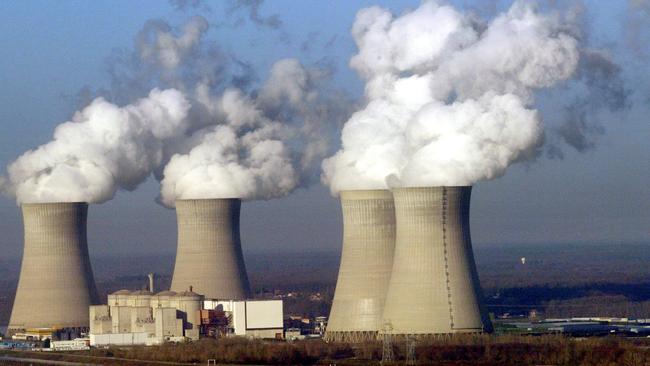
South Australian premier Tom Playford, an inveterate promoter of the development of his state, came close to sealing a deal to have a nuclear plant built using uranium from the state-owned mine at Radium Hill. In the end, technical improvements to the brown-coal fired plant at Port Augusta meant the deal was never completed although Playford was able to sell the uranium to American interests.
It’s worth thinking what taking a different fork in the road at that time would involve for Australia now. In all likelihood we would have several nuclear power plants churning out emissions-free electricity, and debate about the ways and cost of reducing emissions would be very different.
Another former premier, Bob Carr, took to this page last week to throw as much cold water as he could source at the prospect of domestic nuclear energy in this country.
To be sure, his article contained several incontrovertible facts. But to claim “in Australia nuclear attracts not the remotest investor interest” is nonsensical. Several pieces of legislation would need to be changed before investment in nuclear power in Australia would even be possible. Why, therefore, would “a merchant bank or a superannuation fund” waste its time devising a business case for such an investment when it is not legally possible?
The timing of Carr’s piece was also interesting because it occurred in the same week as the release of public opinion polling on attitudes towards nuclear power.
According to Newspoll, nearly two-thirds of voters in Australia support a civil nuclear industry or at least agree that it should be considered. Just over a quarter are firmly opposed. Across time, the proportion of voters who strongly object has fallen.
As an energy crisis affects most of the world, with soaring gas, coal and electricity prices, it is surely time for Australia to have a rational debate about nuclear power leading to a definite outcome.
What will be needed is bipartisan buy-in on the need for a debate as well as co-ownership of any final decisions.
Carr does make the point that the nuclear power industry has stalled in several Western countries, with weak government support and regulatory overkill contributing to plant closures and a lack of investment in new facilities, including ones using the next-generation small modular technology.
The standout here is Germany, where a decision was made by Chancellor Angela Merkel to close down all its nuclear power plants following the Fukushima disaster in 2011. Whereas nuclear power once accounted for more than 20 per cent of electricity generated in Germany, from 2024 that proportion will be zero. The irony is, in its place, the government has had to commission new brown-coal-fired plants and increasingly rely on imported gas from Russia, in addition to using intermittent renewable energy.
But even in Britain the government has prevaricated over the future of nuclear power, notwithstanding the fact there are plants dotted around its coast. The decision to insist that any new plants would attract no government funding as well as tying the sector in costly regulatory red tape has led to a net diminution in the contribution of nuclear power to the generation of electricity in Britain during the past few years.
At the time, there was widespread criticism directed at the terms of approval for the new Hinkley Point C plant that should come into operation in 2026. (It has been on the drawing point for decades.) Back then, the guaranteed electricity price given to investors was twice the going price.
Ironically, that price is now below the prevailing price; it can’t come soon enough for the imperilled British electricity grid.
In the US, there also has been a fairly cool reception to new nuclear facilities although the lives of existing plants have been extended. Even so, the number of operational nuclear reactors has fallen from a high of 110 to 94. In California – a state that prides itself on its climate credentials – the intention is to close the large Diablo Canyon nuclear power plant in the near future.
British House of Lords member Matt Ridley, a prolific writer on innovation and energy, has made the point in the past that the lack of innovation in nuclear power can be linked to the overregulation of the sector and the fact it’s not possible to tinker in the garage with nuclear power.
Of course, this makes the case for government funding of nuclear technology as well as ensuring the regulatory framework is fit for purpose. The Canadian government recently has recognised this fact by streamlining its regulation of nuclear power.
Ridley’s view is that “it’s time to tear up the failed policies of today. (We need to) reform the regulation of nuclear power so that it favours newer, cheaper and even safer designs built in modular form on production lines rather than huge behemoths built like Egyptian pyramids by Chinese investors”. (The latter is a reference to Hinkley Point C.)
While Carr may be correct about the plight of nuclear power in many countries in the West, there are still 50 nuclear power reactors being constructed in 19 countries, including in China, Russia, India and United Arab Emirates.
There are 445 power reactors around the world, operating in 33 countries and producing about 10 per cent of the world’s electricity. There are plans for a further 300 reactors, mainly in Asia. Many of these use or will use uranium sourced from Australia.
Notwithstanding the regulatory straitjacket in many countries, there have been some important technical breakthroughs, including the development of small nuclear reactors by Rolls-Royce and reactors that use nuclear waste. It is also clear that while the cost of the first new nuclear reactor installed may be high, the costs of subsequent ones falls dramatically, by as much as 30 per cent.
It is more than passing strange in a world that places store by net-zero emissions energy that nuclear power should have been kept out of the equation by so many politicians. It is no coincidence, however, that investors have chased the money, seeking the subsidy and ticket-clipping opportunities of renewable energy. That so many Asian countries are continuing to pursue the development of nuclear power should prod us to also consider capturing the opportunity.
We have the sites – old coal-fired plants with transmission lines – and we can safely use nuclear waste. The objections that traditionally were trotted out now look completely passe.




Some readers will be aware that Australia came close to having a domestic nuclear reactor generating electricity in the 1950s.